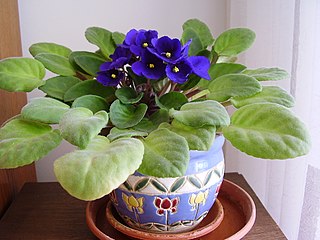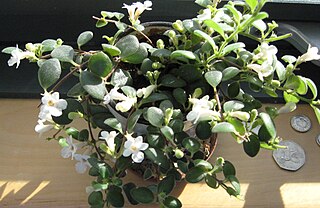
Gesneriaceae, the gesneriad family, is a family of flowering plants consisting of about 152 genera and ca. 3,540 species in the tropics and subtropics of the Old World and the New World, with a very small number extending to temperate areas. Many species have colorful and showy flowers and are cultivated as ornamental plants.

Columnea is a genus of around 200 species of epiphytic herbs and shrubs in the family Gesneriaceae, native to the tropics of the Americas and the Caribbean. The tubular or oddly shaped flowers are usually large and brightly colored – usually red, yellow, or orange – sometimes resembling a fish in shape. A common name is flying goldfish plants due to the unusual flower shape.

Sinningia is a genus of flowering plants in the family Gesneriaceae. It is named after Wilhelm Sinning (1792–1874), a gardener of the Botanische Gärten der Friedrich-Wilhelms-Universität Bonn. There are about 65 species of tuberous herbaceous perennials, all occurring in Central and South America, with the greatest concentration of species occurring in southern Brazil.

Nematanthus is a genus of flowering plants in the family Gesneriaceae. All of its species are endemic to Brazil. Compared to other gesneriads, Nematanthus has leaves that are small, succulent, and hard-surfaced. The plant has a trailing, branching, and spreading habit; it is generally an epiphyte in nature and a hanging-basket plant in cultivation. The flower has fused petals. In some species, the flower has a "pouch" at the bottom. The fancied resemblance of such flowers to a goldfish gives these plants the common name goldfish plant or guppy plant.

Codonanthe is a genus of mainly epiphytic plants in the family Gesneriaceae, endemic to the Atlantic Forest of Brazil. The botanical name comes from the Ancient Greek for 'bellflower'. They have white or pale pink flowers and somewhat fleshy leaves. In 2013, the genus was reduced in size when more than half of the species were transferred to Codonanthopsis. They can be grown as houseplants, particularly in hanging baskets. Artificial crosses with Nematanthus hybrids have produced the hybrid genus × Codonatanthus.
Codonanthopsis elegans is a plant species in the family Gesneriaceae. It is endemic to Belize.

The Gesnerioideae are a subfamily of plants in the family Gesneriaceae: based on the type genus Gesneria. Although genera typically originate in the New World, some species have become widely distributed as ornamental plants.

An ant garden is a mutualistic interaction between certain species of arboreal ants and various epiphytic plants. It is a structure made in the tree canopy by the ants that is filled with debris and other organic matter in which epiphytes grow. The ants benefit from this arrangement by having a stable framework on which to build their nest while the plants benefit by obtaining nutrients from the soil and from the moisture retained there.

Alain Chautems is research associate at the Geneva "Conservatoire et Jardin botaniques de la Ville de Genève, Switzerland. He specialized in some of the most diverse Gesneriaceae of Brazil. Until 2016, he was researcher and curator at the Conservatory and Botanical Garden of the City of Geneva.
Rufodorsia is a genus of epiphytic flowering plants in the family Gesneriaceae. The genus name refers to the reddish back of the upper lobes of the flower. The relationship of Rufodorsia with the genus Oerstedina is uncertain, as of April 2021. It is native to montane cloud forest in Central America.
Oerstedina is a genus of epiphytic flowering plants in the family Gesneriaceae, native to Mexico, Costa Rica and Panama. The relationship of Oerstedina to the genus Rufodorsia is uncertain, as of April 2021.

Codonanthopsis crassifolia is a species of plant in the family Gesneriaceae.
Codonanthopsis anisophylla is a species of flowering plant in the family Gesneriaceae. This species is native in Guyana and mainly grows in wet tropical biomes. The species was first described in the genus Paradrymonia from a specimen collected in 1960, and transferred to Codonanthopsis in 2013.
Codonanthopsis caribaea is a species of flowering plant in the family Gesneriaceae. This species is native to Guadeloupe to North Venezuela, and is a epiphyte and mainly grows in wet tropical biomes. Codonanthopsis caribaea, along with other species in its genus, was first published in 2013.
Codonanthopsis chiricana is a species of flowering plant in the family Gesneriaceae. This species is native to Panama and mainly grows in wet tropical biomes. Codonanthopsis chiricana was first published in 2013.
Codonanthopsis corniculata is a species of flowering plant in the family Gesneriaceae. This species is native to Peru and mainly grows in wet tropical biomes. The species was first described as Codonanthe corniculata by Hans Wiehler in 1977. In 2013 it was placed in genus Codonanthopsis as Codonanthopsis corniculata.
Codonanthopsis erubescens is a species of flowering plant in the family Gesneriaceae. This species is native to Ecuador and mainly grows in wet tropical biomes. Codonanthopsis erubescens was first published in 2013.
Codonanthopsis luteola is a species of flowering plant in the family Gesneriaceae. This species is native to Panamá and mainly grows in wet subtropical biomes. Codonanthopsis luteola was first published in 2013.
Codonanthopsis macradenia is a species of flowering plant in the family Gesneriaceae. This species is native to Belize, Colombia, Costa Rica, Guatemala, Honduras, Mexico, and Panamá, and mainly grows in subtropical biomes. Codonanthopsis macradenia was first published in 2013.

Codonanthopsis uleana is a species of flowering plant in the family Gesneriaceae. This species is native to Mexico and America. Is an epiphyte and mainly grows in wet tropical biomes.













